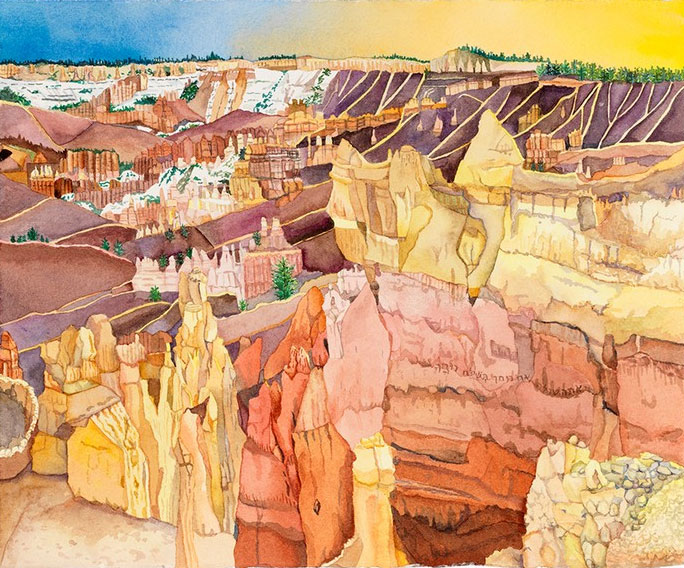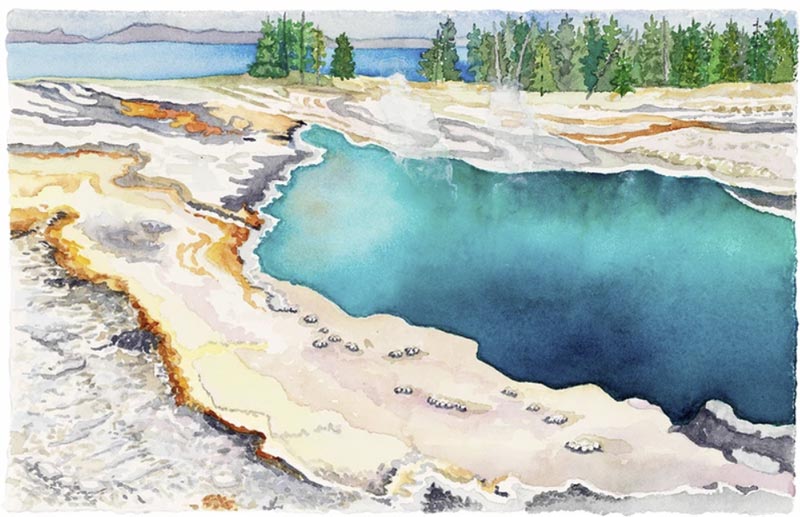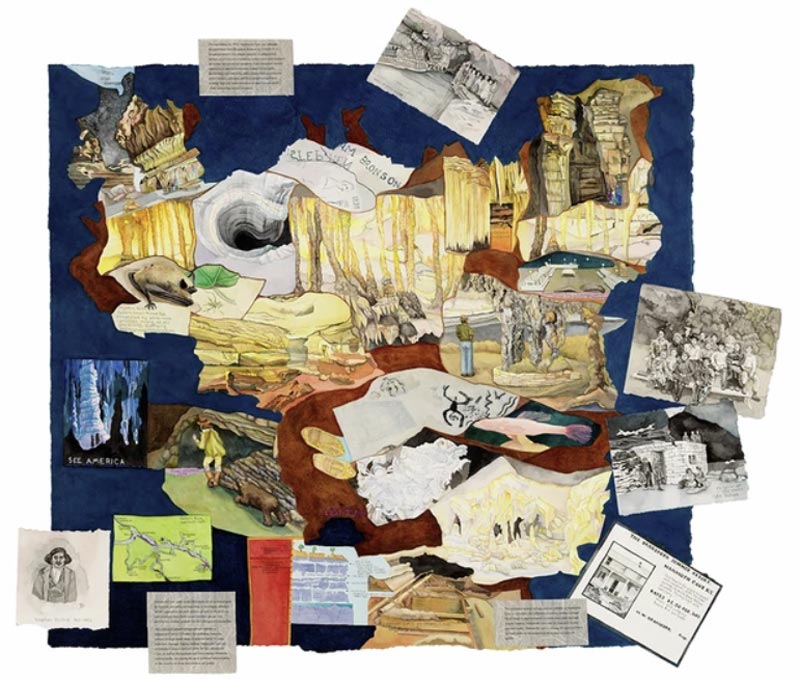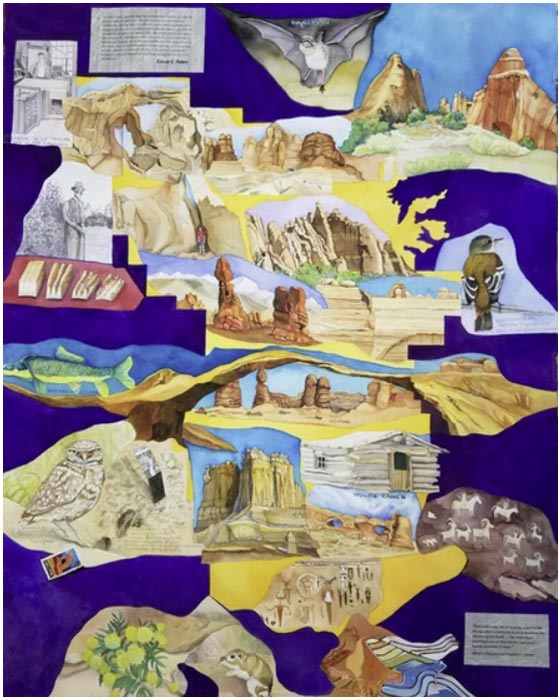Beth Shadur, bethshadur.com, is a renowned artist, educator, muralist and curator who lives in Highland Park, Illinois. Her extraordinary watercolors can be found in numerous collections. She has earned many impressive accolades for her art that celebrates nature’s bountiful beauty and raises awareness about the importance of caring for our planet and our sacred spaces.
Beth received a Special Recognition Art Award in “The Healing Power of Elements: Earth, Water, Air & Fire” online juried exhibition on our other website The Healing Power of ART & ARTISTS. The award acknowledges her magnificent National Park Project series of paintings.
Beth’s numerous solo and group exhibitions include those at the Art Institute of Chicago; the Drawing Center in NYC, NY; the Butler Institute of Art in Ohio; and at the Colorado Springs Art Museum, in Colorado. Her artwork also appears in many publications, books and catalogues, including Twentieth Century Watercolors, Abbeville Press, among others.
She has also created more than 150 large murals as public, private and community art projects in both the U.S. and Great Britain. Her mural work in Barlinnie Prison, Glasgow, Scotland is included in the archives of the Peoples Palace Museum in Glasgow.
In addition to her many distinctions as an artist Beth also serves as the curator and art gallery director at Prairie State College. She is an Artist-in-Education for the Illinois Arts Council in Chicago, IL.
 Light As A Garment: Thy Sendest Forth Thy Spirit (Bryce Canyon National Park), watercolor, 13-5/8″ x 15-3/8″
Light As A Garment: Thy Sendest Forth Thy Spirit (Bryce Canyon National Park), watercolor, 13-5/8″ x 15-3/8″
Beth’s resplendent painting “Light As A Garment: Thy Sendest Forth Thy Spirit” shown above is included in “The Healing Power of Elements: Earth, Water, Air & Fire” exhibition and video on the Manhattan Arts International YouTube channel.
With her entries Beth wrote, “My National Park Project addresses the impact of the National Park designation on First Nation peoples and on local communities. These works are meant to remind us of our responsibility as global citizens to care for our planet and our sacred spaces. For many years, my work has addressed the fragility of nature, and reflected my vast love for nature — including all of the elements. It is only with strong attention to our human impact that we can reverse what are dangerous trends; we must take action now before it is too late.”
It is an honor and pleasure to present this interview with Beth Shadur.
RP: Beth, thank you for submitting your art to the exhibition. What prompted you to participate?
BS: I am very interested in the concept of healing from the arts. I have used my art in a number of ways to promote healing, especially in my mural projects. I strongly believe in the power of art to change lives, and have witnessed it with my own eyes. Art can be a catalyst for change, and can be healing for someone going through various types of trauma.
Of course, an important part of this is my belief in the healing power of nature. I myself go out into nature whenever I “need” it, and approach nature with awe, reverence and sacredness.
 Gasp (Yellowstone), watercolor, 10 ” x 12 1/2″, in a private collection
Gasp (Yellowstone), watercolor, 10 ” x 12 1/2″, in a private collection
RP: What first inspired you to embark upon The National Park Project?
BS: I had been working on addressing human impact on other pristine spaces, such as Banff Provincial Park, where I was an artist in residence, and Iceland, where I was also an artist in residence. When I was in Banff, I was interested in seeing what impact climate change was having, as well as looking at acid rain impact. The Canadian Rockies are truly one of the most beautiful spots on earth, and we think of them as wild and remote, but the impact of man can be felt in too many ways.
After I did a series on those two areas, called “The Fragility of the Sacred”, I decided, with a grant from the Illinois Arts Council, to begin a series on the National Parks.
RP: What reaction do you wish us to have when we view your art?
BS: I hope that people consider how sacred our land is, and how we have disrespected Native Americans, who knew how to take care of this land. I look into the history of these spaces, as well as the takeover by European explorers and settlers, and its impact on the land. Of course, park designation protects the land in certain ways, but also leads to use and abuse of these exceptional lands. I hope to convey the continual presence of Native Americans in protecting the landscapes, and to reflect on how truly beautiful and exceptional this land is. I also want people to be inspired to become stewards of our natural spaces.
 Karst (Mammoth Cave NP), watercolor with mixed media, 41″ x 46″. The Kentucky land on which Mammoth Cave NP exists was occupied by early Native people called “paleo-Indians”. It is considered sacred to the Shawnee, Yuchi and Cherokee tribes.
Karst (Mammoth Cave NP), watercolor with mixed media, 41″ x 46″. The Kentucky land on which Mammoth Cave NP exists was occupied by early Native people called “paleo-Indians”. It is considered sacred to the Shawnee, Yuchi and Cherokee tribes.
RP: What is the strongest impact your National Parks series has made?
BS: I have had many people respond strongly to the work, in terms of reflecting on the beauty, but also on the education provided in this series. I accompany each large work with text that explains how Native people were exploited but consider these lands sacred, and on the history of use of the land for each park I do.
Also, this series has been exhibited throughout the state of Illinois, which I arranged due to the grant that I obtained. It has appeared at various colleges and universities, as well as museums. I hope that the public display of these works promotes thinking on behalf of protection of our natural resources.
 Little Mo (Theodore Roosevelt NP), watercolor, 14″ x 13″, in a private collection
Little Mo (Theodore Roosevelt NP), watercolor, 14″ x 13″, in a private collection
RP: In addition to the National Parks series, what other series are you currently working on?
BS: This series takes up all my time! I currently have over 60 works that I have done since 2018. Occasionally, I work on a work that is part of a project of the Jewish Artists Collective Chicago, of which I am a part. We have done several projects that have inspired other work, including an artists’ Haggadah, and participation in the Violins of Hope, violins that were saved from the Holocaust that are traveling throughout the United States.
RP: Please share information about your role as curator and art gallery director at Prairie State College.
BS: We exhibit 8 shows yearly, 6 of which are by top Midwestern artists. The current one is “Tapestry of Voices: The Poetic Dialogue Project”, where I pair visual artists with poets to create collaborative works. I have done 5 such exhibitions since 2004. I collaborate with a poet, Lois Roma-Deeley, from Arizona, and we have created a handmade artist’s book including poetry and mixed media. This exhibit will be shown at Prairie State College, Chicago Heights, IL and then travel to the Downing Museum in Bowling Green, KY from the beginning of January to mid-February.
 A Different World (Arches NP) watercolor with mixed media, 43″ x 34″. Arches NP resides on land sacred to the Pueblo of Zuni, Hopi, South Ute Indian Tribe, Ute Indian Tribe , Paiute Indian Tribe of Utah, Kaibab Band of Paiute, Las Vegas Paiute, Moapa Band of Paiute, Navajo Nation, Rosebud Sious and San Juan Southern Paiute peoples.
A Different World (Arches NP) watercolor with mixed media, 43″ x 34″. Arches NP resides on land sacred to the Pueblo of Zuni, Hopi, South Ute Indian Tribe, Ute Indian Tribe , Paiute Indian Tribe of Utah, Kaibab Band of Paiute, Las Vegas Paiute, Moapa Band of Paiute, Navajo Nation, Rosebud Sious and San Juan Southern Paiute peoples.
RP: Do you have any current and/or upcoming exhibitions scheduled of your artwork?
BS: I will be showing the National Park Project works at Water Street Studios in Batavia, IL next summer, and am in several juried exhibitions.
RP: What message would you like to send to all readers of this interview?
BS: The impact of the arts can be profound. If you are already an artist, of course you know this on a personal basis. But artists can be powerful advocates for any issue that interests them. And, if you have the bandwidth, you can work with others in your art to allow other participants to understand the wonderful long-term effects of creativity. I believe it is part of our role as artists to help societal change through our work.
Visit Beth Shadur’s website bethshadur.com
Leave a Reply